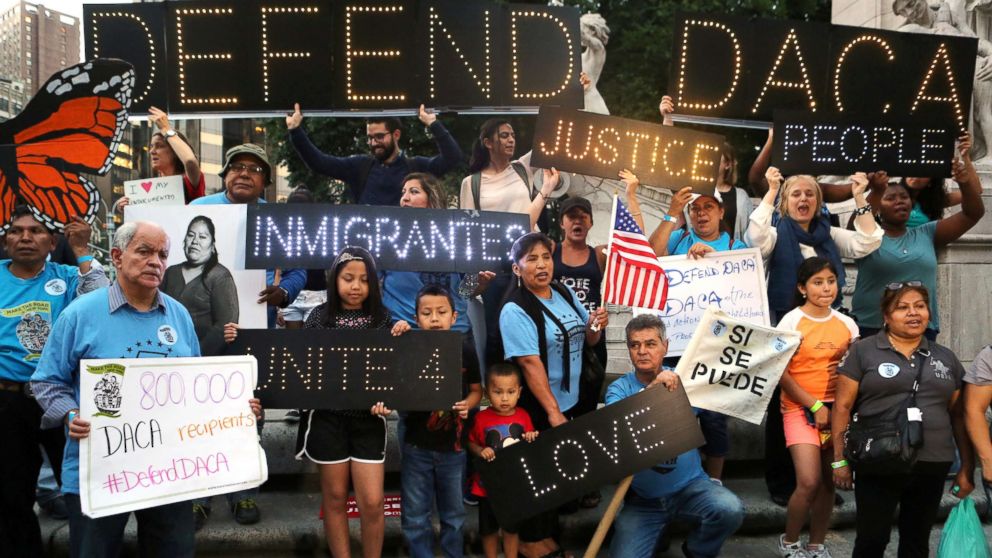What you need to know about DACA
— -- Attorney General Jeff Sessions announced Tuesday that the Trump administration will phase out the Deferred Action for Childhood Arrivals (DACA) policy that was initiated under President Barack Obama in 2012, which protects immigrants who arrived in the United States in their youth from deportation.
President Donald Trump characterized the decision as one made to protect the laws of the U.S., and urged Congress to develop a solution in the next six months before the program is ended.
"I do not favor punishing children, most of whom are now adults, for the actions of their parents," Trump said in a statement. "But we must also recognize that we are nation of opportunity because we are a nation of laws."
The president previously expressed his fondness for the group covered by the policy, saying last week: “We love the Dreamers. We love everybody" -- despite vowing to end the program during his presidential campaign when he labelled it "illegal."
Here’s what you need to know about the program:
What is DACA?
DACA was started by Obama in 2012 to allow certain undocumented immigrants who were children when they were brought to the U.S. to apply for deferred action, and be eligible for work permits.
The policy was implemented as an executive action, and could easily be undone with the stroke of the presidential pen.
What happens when DACA is nixed?
One of the big questions now that Trump has decided to end the program is what will happen to the nearly 800,000 so-called Dreamers who came out of the shadows and registered with the government after the program was introduced. As of July 31, there were 794,846 initial grants since the inception of the program.
It remains to be seen whether these individuals would be turned over to immigration enforcement and be targeted for deportation. Current policy allows U.S. Citizenship and Immigration Services to share information with Immigration and Customs Enforcement (ICE) if it receives an application for someone who has committed a felony crime, or has an outstanding warrant.
Another looming question is what will happen to the work permits. One of the big perks of DACA was that it allowed individuals to obtain a legal work permit. Those permits normally last two to three years, and the question would be whether those are now void immediately, or if they will be phased out.
Why is Trump acting to get rid of the program now?
A group of 10 state attorneys general, led by Texas Attorney General Ken Paxton, set Tuesday as a deadline for the president. In a letter, Paxton wrote that if the administration doesn’t end DACA by Sept. 5, he will amend the complaint in the case against the Deferred Action for Parents of Americans (DAPA) -- a lawsuit Texas fought and won -- to include DACA. This would put the administration in the position of defending the program.
Immigration advocates called the Sept. 5 deadline politically motivated. Marielena Hincapie, executive director of the National Immigration Law Center, said that if Paxton files that amendment by midnight on Sept. 5, the next steps would be laid out by the judge. There is no date set as to when the administration would need to respond.
What has Trump said about the program?
During his presidential campaign, Trump repeatedly promised to end DACA.
“We will immediately terminate President Obama's two illegal executive amnesties in which he defied federal law and the Constitution,” he said at an immigration policy speech in Phoenix during his campaign on Aug. 21, 2016.
Once elected, however, his tone on the matter tempered. In his interview with ABC News’ David Muir in January he reassured DACA recipients.
“They shouldn't be very worried,” he said. “They are here illegally. They shouldn't be very worried. I do have a big heart. We're going to take care of everybody.”
Who’s been fighting to save DACA?
Apple’s Tim Cook, Amazon’s Jeff Bezos, Facebook’s Mark Zuckerberg, and hundreds of entrepreneurs and business leaders from across the country released an open letter calling on Trump to preserve DACA. They’re also pushing Congress to pass legislation to help DACA recipients. The letter and current signatory list can be found here.
Meanwhile, a group of 20 Democratic attorneys general from across the country signed a letter calling on the Trump administration to uphold DACA as a counter to Paxton and the nine other attorneys general planning to fight it. A group of more than 1,800 leaders, including mayors and governors, signed their own letter of support.
Obama also vowed in his last news conference at the White House on January 18 that if DACA recipients were threatened, he would consider that a time when "our core values may be at stake. The notion that we would just arbitrarily, or because of politics, punish those kids when they didn't do anything wrong themselves, I think that would merit me speaking out," Obama said at the time.
Immigration advocates planned a march and rally planned for Tuesday afternoon outside the White House.
What were Trump’s options?
The president could have done nothing, and allowed the matter be decided in the courts. He also could have immediately terminated the program, instead of phasing it out over time.
In announcing the wind down of the policy, the administration is allowing for Congressional action. In July, a bipartisan bill was introduced by Sens. Dick Durbin, D-Ill., and Lindsey Graham, R-S.C., that would grant legal status to many Dreamers. While some conservatives may still oppose the measure, congressional action would remove the objections of presidential overreach pertaining to DACA.
Reps. Ileana Ros-Lehtinen, R-Fla., and Lucille Roybal-Allard, D-Calif., introduced a companion bill in the House, which also gives many of those now covered under DACA a pathway to citizenship.
ABC News’ Geneva Sands and Jordyn Phelps contributed to this report.




